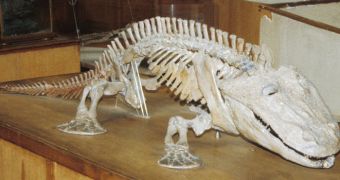Scientists suggest that acid buildup within the body may have been a real problem for the first creatures to walk out of Earth's oceans, tetrapods. These animals are the ancestors of all mammals, amphibians, snakes and so on, but their bodies were not well equipped for living on land at first.
These creatures evolved from lobe-finned fish that lived in the water during the Late Devonian period. When they first emerged from the waves, their bodies were not at all ready to scrub the massive amounts of carbon dioxide that developed within their organisms.
If this operation is not performed, then the level of acid within the body increases until death occurs. Now, investigators suggest that bony structures discovered in the skin of many tetrapods may have played a role in CO2 dispersal and acid level control.
When they left the water, some 370 million years ago, tetrapods needed a few bodily modifications, including lungs and feet. The new research suggests that patches of highly vascular bones in the skin may have played an equally important role in allowing Earth's landmasses to be populated.
“The bony armor of these animals was always a mystery. How would this be an advantage? Even a small amount of vascularized bone could allow you to stay out on land for a few more minutes,” scientist Christine Janis explains.
She holds an appointment as a professor of ecology and evolutionary biology at the Brown University, and was also the lead author of a new paper detailing the findings. The work appears in the latest issue of the esteemed scientific journal Proceedings of the Royal Society B.
It is important to note here that this study does not bring any type of evidence to support the hypothesis. Rather, the research team simply proposed an interesting explanation for the so-called dermal bones.
What is certain is that tetrapods must have had a mechanism for scrubbing CO2 from their bodies and preventing acidity from building up. In addition, several creatures living today still show signs of applying a method similar to the one described by the team.
“The pattern of dermal sculpture in the various early tetrapod taxa can be shown to correspond with patterns of terrestrial versus aquatic habits, with terrestrial forms generally having more pronounced sculpture,” the Brown research team concludes in the paper.

 14 DAY TRIAL //
14 DAY TRIAL //